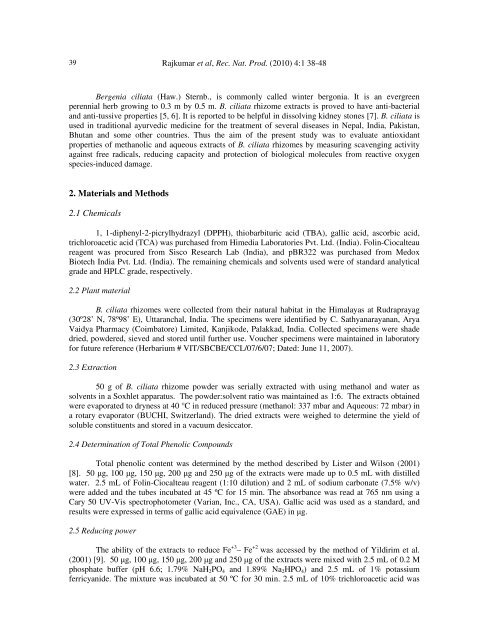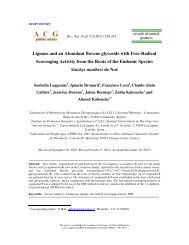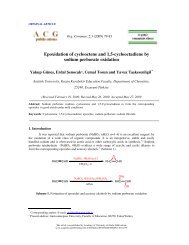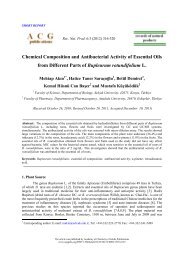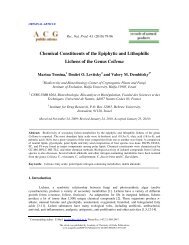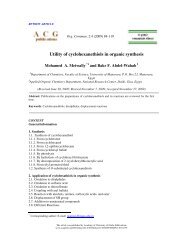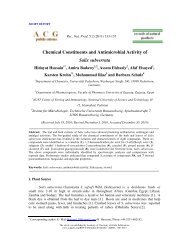Evaluation of Antioxidant Activities of Bergenia ciliata Rhizome
Evaluation of Antioxidant Activities of Bergenia ciliata Rhizome
Evaluation of Antioxidant Activities of Bergenia ciliata Rhizome
Create successful ePaper yourself
Turn your PDF publications into a flip-book with our unique Google optimized e-Paper software.
39Rajkumar et al, Rec. Nat. Prod. (2010) 4:1 38-48<strong>Bergenia</strong> <strong>ciliata</strong> (Haw.) Sternb., is commonly called winter bergonia. It is an evergreenperennial herb growing to 0.3 m by 0.5 m. B. <strong>ciliata</strong> rhizome extracts is proved to have anti-bacterialand anti-tussive properties [5, 6]. It is reported to be helpful in dissolving kidney stones [7]. B. <strong>ciliata</strong> isused in traditional ayurvedic medicine for the treatment <strong>of</strong> several diseases in Nepal, India, Pakistan,Bhutan and some other countries. Thus the aim <strong>of</strong> the present study was to evaluate antioxidantproperties <strong>of</strong> methanolic and aqueous extracts <strong>of</strong> B. <strong>ciliata</strong> rhizomes by measuring scavenging activityagainst free radicals, reducing capacity and protection <strong>of</strong> biological molecules from reactive oxygenspecies-induced damage.2. Materials and Methods2.1 Chemicals1, 1-diphenyl-2-picrylhydrazyl (DPPH), thiobarbituric acid (TBA), gallic acid, ascorbic acid,trichloroacetic acid (TCA) was purchased from Himedia Laboratories Pvt. Ltd. (India). Folin-Ciocalteaureagent was procured from Sisco Research Lab (India), and pBR322 was purchased from MedoxBiotech India Pvt. Ltd. (India). The remaining chemicals and solvents used were <strong>of</strong> standard analyticalgrade and HPLC grade, respectively.2.2 Plant materialB. <strong>ciliata</strong> rhizomes were collected from their natural habitat in the Himalayas at Rudraprayag(30º28’ N, 78º98’ E), Uttaranchal, India. The specimens were identified by C. Sathyanarayanan, AryaVaidya Pharmacy (Coimbatore) Limited, Kanjikode, Palakkad, India. Collected specimens were shadedried, powdered, sieved and stored until further use. Voucher specimens were maintained in laboratoryfor future reference (Herbarium # VIT/SBCBE/CCL/07/6/07; Dated: June 11, 2007).2.3 Extraction50 g <strong>of</strong> B. <strong>ciliata</strong> rhizome powder was serially extracted with using methanol and water assolvents in a Soxhlet apparatus. The powder:solvent ratio was maintained as 1:6. The extracts obtainedwere evaporated to dryness at 40 °C in reduced pressure (methanol: 337 mbar and Aqueous: 72 mbar) ina rotary evaporator (BUCHI, Switzerland). The dried extracts were weighed to determine the yield <strong>of</strong>soluble constituents and stored in a vacuum desiccator.2.4 Determination <strong>of</strong> Total Phenolic CompoundsTotal phenolic content was determined by the method described by Lister and Wilson (2001)[8]. 50 µg, 100 µg, 150 µg, 200 µg and 250 µg <strong>of</strong> the extracts were made up to 0.5 mL with distilledwater. 2.5 mL <strong>of</strong> Folin-Ciocalteau reagent (1:10 dilution) and 2 mL <strong>of</strong> sodium carbonate (7.5% w/v)were added and the tubes incubated at 45 ºC for 15 min. The absorbance was read at 765 nm using aCary 50 UV-Vis spectrophotometer (Varian, Inc., CA, USA). Gallic acid was used as a standard, andresults were expressed in terms <strong>of</strong> gallic acid equivalence (GAE) in µg.2.5 Reducing powerThe ability <strong>of</strong> the extracts to reduce Fe +3 – Fe +2 was accessed by the method <strong>of</strong> Yildirim et al.(2001) [9]. 50 µg, 100 µg, 150 µg, 200 µg and 250 µg <strong>of</strong> the extracts were mixed with 2.5 mL <strong>of</strong> 0.2 Mphosphate buffer (pH 6.6; 1.79% NaH 2 PO 4 and 1.89% Na 2 HPO 4 ) and 2.5 mL <strong>of</strong> 1% potassiumferricyanide. The mixture was incubated at 50 ºC for 30 min. 2.5 mL <strong>of</strong> 10% trichloroacetic acid was


